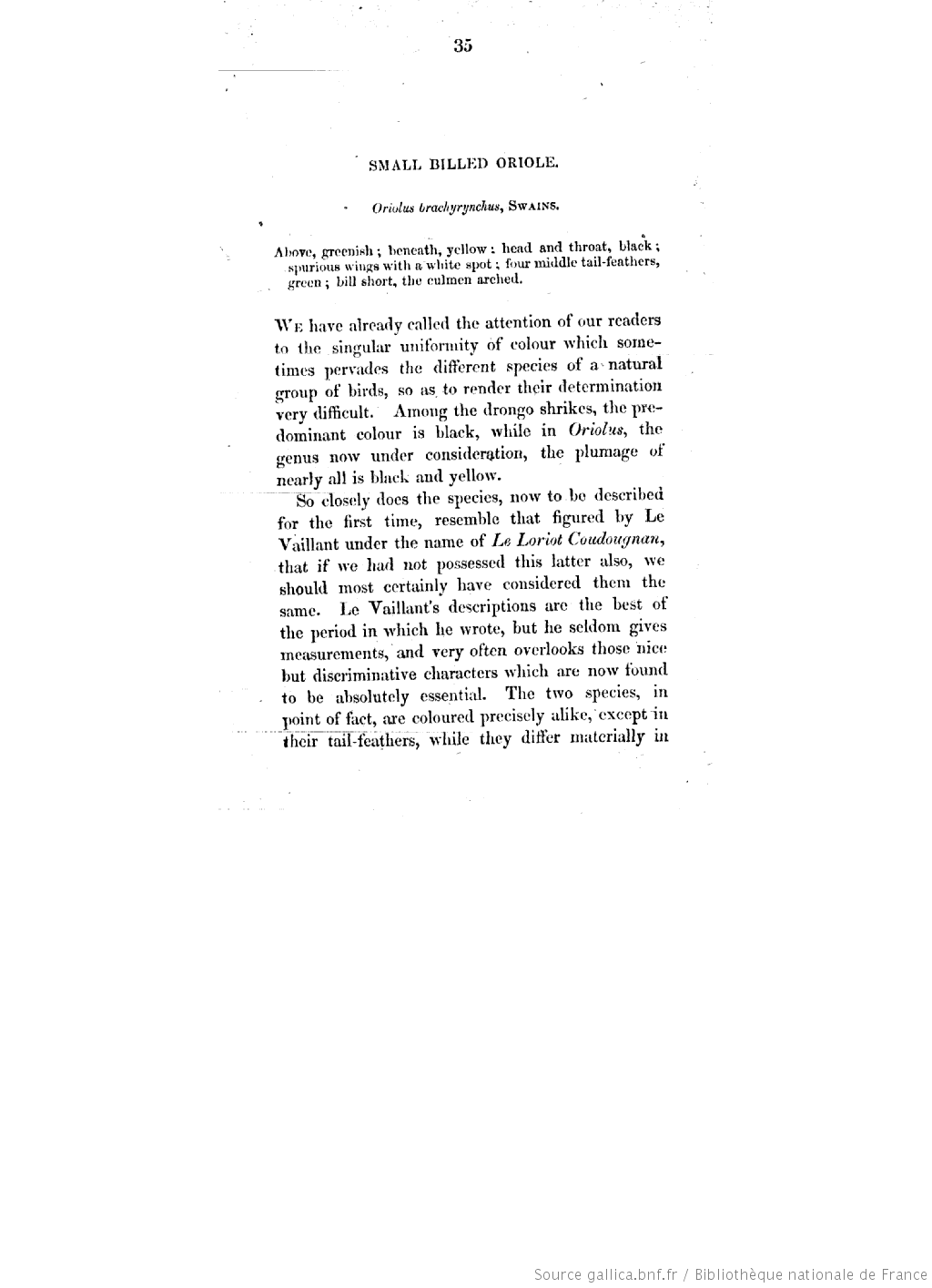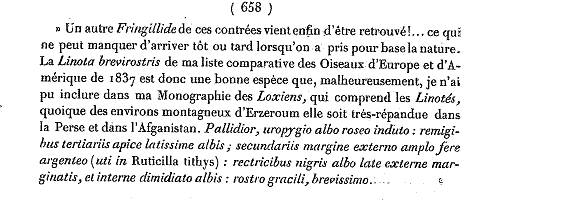

"The following descriptions of new species of Philippine birds have been sent to me by Mr. Ogilvie Grant..."and below:
"Mr. Ogilvie Grant describes the following species as new:--".
The name proposed was spelled blakey -- a lapsus.
Erythrosterna? brunneicauda A. Newton 1863 Proc. Zool. Soc. London p. 180and indeed I believe the description and the name do occur there.
32.5.2.1. In the case of a diacritic or other mark, the mark concerned is deleted, except that in a name published before 1985 and based upon a German word, the umlaut sign is deleted from a vowel and the letter "e" is to be inserted after that vowel (if there is any doubt that the name is based upon a German word, it is to be so treated)..
Dr. Johann Büttikofer (August 9, 1850 - June 24, 1927), was a Swiss zoologist. Büttikofer was born in Ranflüh im Emmenthal and studied biology at Berne. In 1879 he joined the staff of the Royal Zoological Museum in Leiden, becoming curator between 1884 and 1897. He made two trips to Liberia, the first was from 1879 to 1882, and the second from 1886 to 1887. In 1893-94 he accompanied the Nieuwenhuis expedition to central Borneo. Between 1897 and 1924 he was Director of the Zoological Garden at Rotterdam. After his retirement he settled in Berne.
"A taxonomic concept that when published contained no animal then known to exist in nature, past or present, but only in the mind of the author whether a prediction or not."which I think clearly does not apply here.
50.1.1. However, if it is clear from the contents that some person other than an author of the work is alone responsible both for the name or act and for satisfying the criteria of availability other than actual publication, then that other person is the author of the name or act. If the identity of that other person is not explicit in the work itself, then the author is deemed to be the person who publishes the work.
"iris black" (Brenchley)which raises the slight possibility that the authority might possibly be Sharpe & Brenchley.


Psittirostra bailleui.
Foglarne på ön S:t Barthelemy, efter de af Dr A. von Goës hemsända samlingarna bestämde.The name appears first on p.582 where it is spelled
Dendroeca petechia, stirps barthelemcia(not bartholemica). The name is there followed by a detailed paragraph in Swedish which appear to be at least in part a description. In addition, Sundevall uniformly spells the name of the island "S:t Barthelemy" thoughout his paper.
[Dendroeca petechia] a) bartholemica (ex insula S:t Barthelemy).with a diagnosis (in Latin).
Quiscalus brachypterus Cassin, 1867, Proc. ANSP (1866), 18, p. 406
1941 Ark.Zool. 33B no.13 p.005 Cnemotriccus fuscatus beniensis Gyldenstolpe H&M p.366 1941 Peters 8:147 1941 1941 Ark.Zool. 33B no.13 p.006 Cymbilaimus sanctaemariae Gyldenstolpe H&M p.379 1941 Peters 7:154 1941 1941 Ark.Zool. 33B no.013 p.007 Hylopezus auricularis Gyldenstolpe H&M p.400 1941 Peters 7:271 1941
['Peters' was right. OD checked]This does not seem to make sense. Peters 14:185, as I indicated, shows the date as 1942 (sic). So the note should read: "['Peters' (=Blake) was wrong].
Tyrannulus brunneicapillus Lawrence, 1862, must be spelt Ornithion brunneicapillus, and should not be changed to O. brunneicapillum.
The original is indeed boissonneautii, but the authors write: "nous la dédions à M. Boissonneau." (we dedicate the name to Mr. Boissonneau).
32.5. Spellings that must be corrected (incorrect original spellings). 32.5.1. If there is in the original publication itself, without recourse to any external source of information, clear evidence of an inadvertent error, such as a lapsus calami or a copyist's or printer's error, it must be corrected. Incorrect transliteration or latinization, or use of an inappropriate connecting vowel, are not to be considered inadvertent errors.My initial interpretation was that under the current Code the species group name must be corrected to boissonneauii; arguing that boissonneautii is an "incorrect latinization", and thus requiring it remain the same, seemed unsupportable.
Note that art. 31.1.1 gives much latitude to authors. For example, the name Margaret can be latinized to Margarita or Magaretha, yielding the genitives margaritae or margarethae. Now, can we have Boissonneau = boissonneautius = boissonneautii ? The more I think about it, the more I am inclined to say that "boissonneautii" may not be correctible.
Probably named for Ferdinand Bauer who collected (plants only?) in Australia circa 1805.
The timeline suggested by Richmond's cards is as follows:
"This name and a slight diagn. is quoted in a letter to Capt. Thos. Brown by Messrs. John + Albany Hancock (or one of them) an extract from which is given as above".The Richmond Index card for Anas Cygneus Bewickii
18. PSARIS Brasziliensis. Cinereous white: head, ears, chin spot, wings and tail black: orbits, naked,: bill black, the marginal base red. Female with the head, ears, and back, dark cinereous, striped with blackish: lenght of the wing, about five inches. Inhabits Northern Brazil. Differs from Cayanensis in having the orbits red and naked; and from Guinensis in being larger, in the bill being entirely black beyond the nostrils, and in the female being without a black hood on the head and ears, as in that species. It is the largest and commonest of Brazil.
E. b. cyanothorus (Vieillot, 1818).
The closest name I find to this is Psittacus cyanonothus Vieillot Nouv.Dict.Hist.Nat. XXV p.334. The citational orthography of this volume of the HBW makes it impossible to determine which page number they associate with which name, but for the Vieillot names from 1818 (HBW 5:615) they list pp. 346,358,366.Celeus brachyurus squamigularis (Sundevall) 1866 Consp.Av.Picinarum p.89
Dioptrornis brunnea Cabanis, 1886, Journ. Ornith., 34, pl. 1, fig. 1, and Bradyornis (Dioptrornis) brunnea Cabanis, 1887, Journ. Ornith., 35, p.92
Alectoris barbara 1791
"Page 119, line 26, for "bazlei" read "bayleii".This would seem to satisfy the Code requirements for a correction.
Bruce & McAllan [Boll. Mus. Reg. Sci. Nat. Torino 8 (1990): 453-485] showed that Gould described this species 3 times. The descriptions in The Athenaeum and The Literary Gazette appeared on the same day, 12 Dec. 1857, whereas the description in PZS appeared on 28 Jan. 1858. They chose the paper in The Athenaeum as original publication of C. bennetti.
Myrmeciza berlepschi
Amazilia beryllina Deppe
Streptopelia bitorquata 1809
1848. "Commenced in the middle of 1848, and in the latter part of that year, Three parts were Published." 10 pls. Price 9 shillings. 1849. "Seven Parts have been Published." 27 pls. Price 21 shillings. 1850. "Seven Parts have been Published." 21 pls. Price 21 shillings. 1851. "Six Parts have been Published." 14 pls. Price 18 shillings. 1852. "Seven Parts have been Published." 20 pls. Price 24 shillings.As this taxon is plate number 38, and it appears that 37 plates had been published by the end of 1849, 1850 would seem the date for this taxon.
Apus berliozi
Not in Peters Checklist Vol.4.
Helbig AJ, Martens J, Seibold I, Henning F, Schottler B, Wink M. Phylogeny and species limits in the Palearctic chiffchaff Phylloscopus complex: mitochondrial genetic differentiation and bioacoustic evidence. 1996. Ibis 138(4):650-666
Heliactin bilophus Systematics/Nomenclature
M N. David writes:
"I think that Dromaius baudinianus Parker 1984 (BBOC 104: 19-22) should be recognized. HANZAB has it, presumably founded on bones (I have not seen BBOC 104). But Jouanin 1959 (Oiseau & RFO 29: 169-203) tells the whole story of Baudin's expedition. It is extremely complicated. In short: birds (some alive, some dead) were brought back to France from King and Kangaroo islands; there are extant specimens to substantiate D. ater (from King I.) and at least one (now in Geneva) from Kangaroo I. At the time (=1959), the Kangaroo I. specimen had not received a formal name. I feel that it could be included in baudinianus Parker 1984. Parker 1984 (BBOC 104: 19-22) described the species from bone material. Balouet, J. C. & C. Jouanin. 1990. Systematique et origine geographique des emeus recoltés par l'expedition Baudin. Oiseau & RFO 60: 314-318. In this paper, they established that:From what I know, birds kept alive in Paris, did not bred but lived for over 20 years."
- a Paris museum specimen is D. ater
- the Firenza museum specimen is D. ater
- a Paris skeleton is D. baudinianus
- the Genova skin (boneless, undoubtedly separated from the Paris skeleton) is D. baudiniaus.
Fam. HIRUNDINIDÆ
Genus HIRUNDO, Auct.
10. HIRUNDO BREVIROSTRIS. Suprà nigricans nitore olivaceo;
subtùs fuscescens, alis elongatis; caudâ mediori subfurcatâ; ros-
tro brevissimo.
This species agrees with Hirundo fuciphaga in habitat, in propor-
tional length of the wing, and shortness of beak, and in colour above;
but it is darker underneath, and more than one third larger: entire
length six inches.
~~~~~~~~~~~~~~~~~~~~~~~~~~~~~~~~~~~~~~~~~~~~~~~~~~~~~~~~~~~ Monarcha (Piezorhynus) browni E.P. Ramsay. 1883. Proc. Zool. Soc. London, 1883, Part IV, April, 1883, 711. Type locality: "Marrabo," Solomon Group. Coll. for Rev. Geo. Brown. ~~~~~~~~~~~~~~~~~~~~~~~~~~~~~~~~~~~~~~~~~~~~~~~~~~~~~~~~~~~
*23. C. binotatus, Temm. Mus. Lugd. ex Borneo. Nigri- cans, abdomine subtiliter rufo-vermiculatus: colli macula utrinque alba: remigibus fuscis rufo-maculatis: rectricibus omnibus atro rufoque variis, sine maculis albis.
